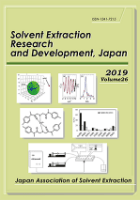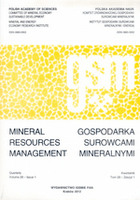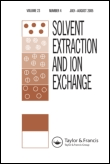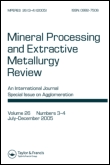
SOLVENT EXTRACTION RESEARCH AND DEVELOPMENT-JAPAN
Scope & Guideline
Advancing solvent extraction for a sustainable future.
Introduction
Aims and Scopes
- Solvent Extraction Techniques:
The journal emphasizes the development and refinement of various solvent extraction techniques, including liquid-liquid extraction, solid-phase extraction, and the use of novel solvents such as ionic liquids and deep eutectic solvents. - Separation of Metal Ions:
A core area of research involves the extraction and separation of metal ions from various matrices, including waste streams, brines, and acidic solutions, focusing on metals such as lithium, rare earth elements, and transition metals. - Environmental and Economic Applications:
The journal highlights studies that contribute to environmental sustainability and economic efficiency, including the recovery of valuable resources from waste, the use of green solvents, and the reduction of hazardous materials in extraction processes. - Kinetic and Thermodynamic Studies:
Research often includes detailed kinetic and thermodynamic analyses of extraction processes to understand the mechanisms involved and optimize conditions for maximum extraction efficiency. - Innovative Extraction Methods:
The journal features advancements in extraction methodologies, such as ultrasound-assisted extraction, microwave-assisted extraction, and the use of supported ionic liquid membranes, showcasing innovative approaches to enhance extraction performance.
Trending and Emerging
- Lithium Extraction:
With the rising demand for lithium in battery technologies, research on lithium extraction from various sources, including brines and magnesium-rich solutions, has become increasingly prominent, indicating a shift towards addressing the needs of the energy sector. - Ionic Liquids and Green Solvents:
There is a growing trend towards the use of ionic liquids and other novel green solvents for extraction processes, driven by the need for more sustainable and less toxic alternatives in the field. - Recovery of Rare Earth Elements:
The extraction and recovery of rare earth elements are gaining traction, particularly in the context of resource scarcity and the need for sustainable practices in high-tech industries. - Biological and Plant-based Extraction:
Emerging studies focus on the use of biological methods and plant cell cultures for the extraction of valuable compounds, such as paclitaxel, highlighting a trend towards more environmentally sustainable and bio-based extraction processes. - Use of Machine Learning in Extraction Processes:
The integration of machine learning techniques for predicting extraction efficiencies and optimizing extraction conditions is an emerging theme, showcasing the intersection of computational techniques with experimental solvent extraction research.
Declining or Waning
- Traditional Solvent Systems:
Research on conventional solvent systems, such as organic solvent mixtures, has seen a decline as researchers increasingly explore greener alternatives, such as ionic liquids and deep eutectic solvents, which are perceived as more environmentally friendly. - Basic Extraction Mechanisms:
There appears to be a waning interest in purely theoretical studies focusing on basic extraction mechanisms without practical applications, as the field moves towards studies that emphasize practical, real-world applications and implications. - Extraction of Common Metals:
The frequency of studies dedicated to the extraction of common metals like copper and aluminum from standard sources has decreased, possibly due to saturation in this area and a shift towards more complex or valuable metal recovery processes.
Similar Journals

FOOD AND BIOPRODUCTS PROCESSING
Innovating solutions for global food security challenges.FOOD AND BIOPRODUCTS PROCESSING, published by Elsevier, is a leading journal dedicated to advancing the fields of biochemistry, biotechnology, chemical engineering, and food science. With a strong impact factor and robust rankings—Q2 in Biochemistry and Biotechnology, and Q1 in Food Science—it serves as an essential resource for researchers, industry professionals, and students alike. The journal focuses on innovative research and practical applications in the processing of food and bioproducts, spanning from raw material transformation to product development. By fostering the exchange of knowledge and ideas, FOOD AND BIOPRODUCTS PROCESSING aims to enhance food quality and sustainability while addressing global challenges in food security and environmental impact. With an accessible format and a diverse pool of contributors, this publication stands as a vital platform for groundbreaking studies, making significant contributions to the advancement of technology and practices in food processing and production.

Gospodarka Surowcami Mineralnymi-Mineral Resources Management
Pioneering Research in Mineral SustainabilityGospodarka Surowcami Mineralnymi-Mineral Resources Management is a pivotal academic journal published by the Polish Academy of Sciences and the Mineral and Energy Economics Research Institute. Focusing on the field of Economic Geology, this journal plays a critical role in disseminating research on mineral resources management, exploring the economic implications of mineral exploitation, sustainability practices, and technological advancements in resource extraction. With an ISSN of 0860-0953 and an E-ISSN of 2299-2324, the journal has established itself as a respected source of knowledge, holding a Q3 ranking in its category as of 2023 and demonstrating its relevance within a competitive landscape where it ranks 22nd out of 43 in Economic Geology according to Scopus. Researchers, professionals, and students will find this journal to be an invaluable resource for the latest insights and developments in mineral resource management, contributing significantly to the overarching conversations in geology and environmental science.

THEORETICAL FOUNDATIONS OF CHEMICAL ENGINEERING
Exploring the Depths of Chemical Engineering KnowledgeTHEORETICAL FOUNDATIONS OF CHEMICAL ENGINEERING is an esteemed academic journal published by PLEIADES PUBLISHING INC, dedicated to advancing the field of chemical engineering and chemistry through rigorous theoretical discourse and scholarly communication. With a history of publication dating back to 1974, the journal has been a vital resource for researchers and professionals, contributing to the foundation of knowledge in this multidisciplinary domain. Although it does not offer open-access options, it remains an essential platform for innovative research, boasting a 2023 ranking in the Q3 quartile for both Chemical Engineering and General Chemistry categories. The journal is indexed in Scopus, where it ranks #210 out of 273 in Chemical Engineering and #317 out of 408 in Chemistry, emphasizing its growing relevance within the scholarly community. Researchers, educators, and students alike can benefit from the insights and findings shared within its pages, making it a critical venue for those seeking to enhance their expertise in theoretical chemical engineering.

Mineral Processing and Extractive Metallurgy-Transactions of the Institutions of Mining and Metallurgy
Unlocking the Science of Resource ExtractionMineral Processing and Extractive Metallurgy - Transactions of the Institutions of Mining and Metallurgy is a premier journal published by SAGE Publications Inc that aims to provide a dynamic platform for researchers, professionals, and students in the fields of mineral processing, extractive metallurgy, and related disciplines. With an ISSN of 2572-6641 and E-ISSN 2572-665X, this journal spans a diverse range of topics including geochemistry, geotechnical engineering, and the latest advancements in mining technologies. Currently classified in the Q3 quartile across various categories, it holds commendable rankings in Earth and Planetary Sciences and is recognized for its impactful contributions to the science of resource extraction. The journal accepts contributions from both theoretical and applied perspectives, fostering a multidisciplinary approach to mineral resource utilization. Researchers can access cutting-edge studies that break new ground in extraction techniques and processing innovations, enhancing the sustainability of mining operations. Since its inception in 2018, it has consistently attracted a global readership, making it an essential resource for those dedicated to advancing the fields of geology and metallurgy.

SOLVENT EXTRACTION AND ION EXCHANGE
Elevating Knowledge in Solvent Extraction MethodologiesSOLVENT EXTRACTION AND ION EXCHANGE is a prominent academic journal dedicated to the field of Chemical Engineering and Chemistry, published by Taylor & Francis Inc. With its ISSN 0736-6299 and E-ISSN 1532-2262, the journal serves as a vital resource for researchers and practitioners seeking to advance their understanding and application of solvent extraction and ion exchange methodologies. Recognized for its impact, the journal holds respectable rankings, placed in Q2 for Chemical Engineering and Q3 for Chemistry as of 2023, reflecting its significant contribution to the academic community. The journal covers a wide range of topics from fundamental studies to innovative applications, enhancing both theoretical perspectives and practical implementations. With a robust readership spanning across the globe, SOLVENT EXTRACTION AND ION EXCHANGE not only facilitates the dissemination of critical research findings but also encourages interdisciplinary collaboration and knowledge sharing among scientists, engineers, and students alike. Researchers are invited to contribute to this esteemed journal, which works to illuminate the evolving landscape of chemical processing and separation technologies.

Mineral Processing and Extractive Metallurgy Review
Exploring Cutting-Edge Developments in Extractive MetallurgyMineral Processing and Extractive Metallurgy Review, published by Taylor & Francis Inc, is a leading academic journal dedicated to advancing the field of mineral processing and extractive metallurgy. With a strong focus on innovative research and methodological advancements, this journal serves as a critical resource for researchers, professionals, and students alike, offering insights into the latest developments in the extraction and processing of minerals. Currently holding a prestigious Q1 ranking across multiple categories, including Chemistry (Miscellaneous), Economic Geology, and Mechanical Engineering, it demonstrates a significant impact in the scientific community, evidenced by its ranking in the 93rd percentile in Mechanical Engineering and Geotechnical Engineering. This journal is pivotal for anyone involved in the study and application of mineral resources, making it an essential read for those looking to deepen their understanding of the relationship between mineralogy and technology-driven solutions in modern engineering. In addition to its traditional subscription-based model, the journal aims to promote wider accessibility to such crucial knowledge within the industry.

JOURNAL OF SOLUTION CHEMISTRY
Exploring the Depths of Chemical InteractionsJournal of Solution Chemistry, published by Springer/Plenum Publishers, offers a vital platform for researchers and professionals engaged in the complex interplay of substances in solution, focusing on the interdisciplinary aspects of Biochemistry, Biophysics, Molecular Biology, and Physical and Theoretical Chemistry. Established in 1972 and traversing to 2024, this journal features extensive research articles that contribute significantly to the understanding of solution chemistry phenomena. Although it is categorized as Q4 in Biochemistry and Molecular Biology and Q3 in Biophysics and Physical and Theoretical Chemistry, the journal is set apart by its commitment to fostering innovative studies and methodologies within these domains. With an ISSN of 0095-9782 and an e-ISSN of 1572-8927, it remains accessible to a wide range of scholarly audiences despite the absence of open access options. As an essential resource for anyone invested in the foundational aspects of chemical interactions, the Journal of Solution Chemistry continues to shape the discourse in solution-based research, making it a critical asset for ongoing academic pursuits.

Journal of Essential Oil Bearing Plants
Connecting Chemistry with Nature's EssenceJournal of Essential Oil Bearing Plants, published by Taylor & Francis Ltd, is a peer-reviewed academic journal that plays a critical role in the field of essential oils and their applications in analytical chemistry, biochemistry, and organic chemistry. With an ISSN of 0972-060X and an E-ISSN of 0976-5026, this journal has been a valuable resource since its inception in 2003 and continues to publish cutting-edge research through 2024. The journal is classified in the Q2 category for Analytical Chemistry and Q3 for both Biochemistry and Organic Chemistry as of 2023, reflecting its high citation impact and relevance in these scientific domains. Researchers and practitioners will find a wealth of knowledge in its pages, showcasing innovative methodologies and findings that advance our understanding of essential oils and their diverse applications. While the journal does not currently offer Open Access options, its rigorous peer-review process ensures that published studies maintain the highest standards of scientific integrity. Located in the United Kingdom, the Journal of Essential Oil Bearing Plants is dedicated to disseminating essential research findings to a global audience, thereby facilitating ongoing dialogue and development in this important field.

Separations
Innovating for a Cleaner, More Efficient WorldSeparations is a prestigious open-access journal published by MDPI, dedicated to advancing the fields of analytical chemistry and filtration and separation processes. Established in 2014, the journal has swiftly emerged as a significant platform for disseminating groundbreaking research and innovative methodologies in separation science, boasting an impressive E-ISSN of 2297-8739 and operating out of Basel, Switzerland. With its focus rotating from 2016 through 2024, Separations has been categorized in the Q3 quartile for both analytical chemistry and filtration and separation disciplines as of 2023, demonstrating its relevance in these scientific areas. The journal's rankings in Scopus, with 93rd out of 156 in analytical chemistry and 15th out of 19 in chemical engineering filtration and separation, reflect its commitment to high-quality research accessible to a global audience. Researchers, professionals, and students will find valuable insights and pioneering findings that foster collaboration and innovation within the vibrant community of separation science.

Machine Learning and Knowledge Extraction
Connecting Minds to Foster Knowledge in Machine LearningMachine Learning and Knowledge Extraction, published by MDPI, is an esteemed Open Access journal that has been at the forefront of disseminating cutting-edge research since its inception in 2019. Based in Switzerland, this journal has established itself as a significant contributor to the fields of Artificial Intelligence and Engineering, currently ranking in the Q2 category in Artificial Intelligence and Q1 in Engineering (miscellaneous) for 2023. With a notable Scopus ranking, it holds the 35th position out of 204 in Engineering, placing it in the 83rd percentile, while it ranks 127th out of 350 in Computer Science, reaching the 63rd percentile. Machine Learning and Knowledge Extraction serves as a vital platform for researchers, professionals, and students alike, promoting insightful discussions, innovative methodologies, and profound discoveries in machine learning and data extraction techniques. The journal's open access model ensures that groundbreaking research is widely accessible, fostering collaboration and advancing knowledge across various disciplines.